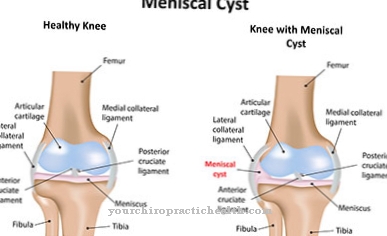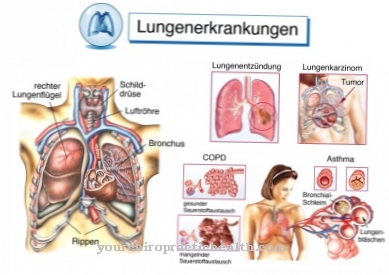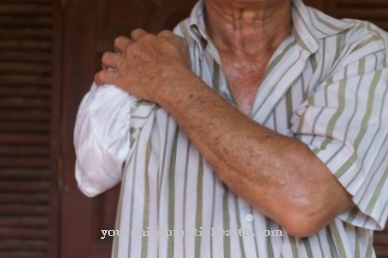The Vogt-Koyanagi-Harada syndrome is a multifactorial disease, the cause of which is not yet fully understood. However, an autoimmune reaction against the melanocytes mediated by the T cells can be assumed. A virus as a trigger is also possible. The main symptom of the disease is chronic uveitis. Early diagnosis and early start of aggressive therapy are important to maintain vision.
What is Vogt-Koyanagi-Harada Syndrome?
The Vogt-Koyanagi-Harada syndrome is a multifactorial disease in which chronic uveitis, a chronic inflammation of the iris, is in the foreground. The main symptom, chronic uveitis, can be classified according to the anatomical origin.
There is a subdivision into: the anterior uveitis, the posterior uveitis, the intermedia uveitis and the panuveitis. In the case of anterior uveitis, the anterior part of the iris is affected; a further differentiation can be made between iritis and cyclitis. If there is posterior uveitis, the posterior parts of the iris are affected - the retina, choridea, vitreous body, macula or otic nerve.
In contrast, intermedia uveitis is an inflammation in the middle area of the iris. If panuveitis is present, all parts of the iris are affected by the inflammation. Symptoms of uveitis, which are present in all variants, are pain, sensitivity to light, tearing and a feeling of foreign body.
In the case of anterior uveitis, there is also reddening of the eye, whereas in the case of posterior uveitis, the focus is on impaired visual acuity. Due to the symptoms, medical laypeople often confuse uveitis with conjunctivitis. In addition to the chronic inflammation of the iris as described, various secondary diseases occur.
These include retinal detachment, vitreous opacity, papillitis with atrophy of the optic nerve and glaucoma, meningitis, various skin symptoms such as poliosis (white discoloration of body hair), vitiligo (disease characterized by pigment loss) and hair loss (alopecia).
Inner ear symptoms can also occur, such as increased sensitivity to high notes. The disease occurs mainly in heavily pigmented people between the ages of 20 and 50.
causes
The exact causes of the syndrome have not yet been clarified. However, it can be assumed that the disease is triggered either by a virus or by T-cell-mediated autoimmune reactions against melanocytes. The T cells belong to the group of lymphocytes.
They are created like other blood cells in the bone marrow. The differentiation takes place in the thymus. Because of the location of the differentiation, the cells are called T cells. (T stands for thymus) The T cells recognize antigens foreign to the body via a receptor, the so-called T cell receptor (TCR).
They therefore represent part of the human immune system and react to antigens that are foreign to the body. The melanocytes are pigment-forming cells of the skin, which make up about five to ten percent of the cells of the epidermal basal cell layer. In addition to the epidermal basal cell layer, the melanocytes are found in the outer root sheath and in the bulb of the hair follicle.
The melanocytes have the melanosome, a cell organelle which arises from pigmentless premelanosomes, structureless, heavily pigmented and an electron microscopic characteristic of the melanocyte. The skin pigment melanin, which is synthesized from tyrosine, is stored in the melanosome and passed on to neighboring upward migrating keratinocytes. The melanocytes themselves are not heavily pigmented because they constantly pass the melanin on to the keratinocytes.
The more melanin the human body produces, the more pigmented it is. If the T cells now react to the melanocytes, this can be described as an autoimmune reaction, since the T cells, contrary to their actual function, do not react to a foreign antigen but to the body's own cells. In this case, we speak of so-called autoimmune diseases - the immune system or the immune defense is directed against the body's own structures.
Symptoms, ailments & signs
In the clinic, Vogt-Koyanagi-Harada syndrome is particularly noticeable due to chronic uveitis and various secondary diseases. Many patients mistake (chronic) uveitis for conjunctivitis because the symptoms are sometimes very similar. Pain, a foreign body sensation, and anterior uveitis, reddening and sensitivity to light occur.
In the posterior variant of uveitis, however, there is no reddening of the eye, but a reduction in visual acuity. In addition to the chronic inflammation of the iris, various other ophthalmic diseases occur. Retinal detachment, vitreous opacity and papilitis with secondary atrophy of the optic nerve and glaucoma should be mentioned here.
In addition to the mentioned diseases of the eyes, various other secondary diseases occur: meningitis, skin and inner ear symptoms. More pigmented people are particularly affected. The onset of the disease usually falls between the ages of 20 and 50.
Diagnosis & course of disease
The diagnosis is made clinically. This means that there are no tests of their own to determine whether Vogt-Koyanagi-Harada syndrome is present. The diagnosis of the syndrome is made solely on the basis of the existing symptoms or the existing secondary diseases.
On the basis of the symptoms that exist outside of the ophthalmological complaints, a complete, an incomplete or a probable diagnosis is spoken of. The prognosis of the disease with regard to the preservation of vision is good if the syndrome is identified in good time and treatment is started in good time.
Complications
Vogt-Koyanagi-Harada syndrome can lead to a number of different complaints and thus have a very negative effect on the quality of life of the person affected. Most patients often suffer from conjunctivitis, which in the worst case can lead to blindness. Pain or a foreign body sensation can also occur in the eye and have a negative effect on the eyesight of the person concerned.
Furthermore, the Vogt-Koyanagi-Harada syndrome leads to a significantly increased sensitivity to light. The iris can also become inflamed and the patient's eyesight can continue to deteriorate. Especially in children or young people, sudden visual problems can lead to severe psychological problems or to depression.
In the case of blindness, those affected depend on the help of other people or their parents in their lives and are significantly restricted in their everyday lives. Since the Vogt-Koyanagi-Harada syndrome cannot be treated causally, only the individual symptoms are treated with the help of medication. There are usually no complications or other complaints.
However, the patients are always dependent on taking the medication. Vogt-Koyanagi-Harada syndrome does not have a negative impact on the patient's life expectancy.
You can find your medication here
➔ Medicines for eye infectionsWhen should you go to the doctor?
With Vogt-Koyanagi-Harada syndrome, a visit to a doctor is usually necessary. This disease cannot cure independently, so the person affected should contact a doctor as soon as the first symptoms and signs of the disease appear. An early diagnosis with subsequent treatment always has a very positive effect on the further course of the disease and can prevent further complications.
In the case of Vogt-Koyanagi-Harada syndrome, a doctor should be contacted if the patient suffers from very severe pain in the eyes. This pain occurs for no particular reason and does not go away on its own. A foreign body sensation in the eye can also indicate the syndrome and should also be examined by a doctor.
The eyesight also decreases and there is a strong reddening of the eye. In some cases, a clouded vitreous humor can indicate Vogt-Koyanagi-Harada syndrome. The disease can usually be recognized and treated by an ophthalmologist. The further course depends heavily on the time of diagnosis.
Treatment & Therapy
The therapy is aggressive with high-dose steroids. In the longer term, immunosuppressants, substances that suppress the body's immune system, can also be used. Ciclosporin, for example, could be mentioned as an active ingredient. The steroids are given systemically. The steroids have anti-inflammatory effects.
prevention
Prevention is not possible.
Aftercare
With Vogt-Koyanagi-Harada syndrome, those affected have only very limited and very few direct follow-up measures available. Since this is a congenital disease, it can usually not be completely cured. Therefore, the person affected should ideally see a doctor at the first signs and symptoms of the disease and also initiate treatment to prevent the occurrence of other complaints.
A genetic examination and counseling is also very useful if you want to have children and should be carried out to prevent the occurrence of the syndrome in your descendants. Most people affected by this disease are dependent on various surgical interventions, with which the symptoms and malformations can usually be alleviated.
In any case, the person affected should rest and take it easy after the procedure. Exertion or stressful and physical activities should be avoided in order not to unnecessarily burden the body. The treatment of Vogt-Koyanagi-Harada syndrome is still carried out through the measures of physiotherapy or physiotherapy. Those affected can also repeat many of the exercises at home and thus accelerate the healing process. In some cases, this disease also limits the person's life expectancy.
You can do that yourself
Vogt-Koyanagi-Harada syndrome requires medical treatment. The therapy of malformations and functional disorders of the body can be supported by various self-help measures.
The skin symptoms can be treated with natural care products from the drugstore or pharmacy. The use of aggressive creams or ointments should first be discussed with the doctor, as complications can occur. Ear protection can be worn if there is an increased sensitivity to high-pitched tones, as occurs in the context of typical inner ear symptoms. In addition to ear plugs, classic earmuffs are also available. In the event of severe symptoms such as fever or gastrointestinal complaints, such as those that occur in connection with meningitis, rest and rest. You should also drink a lot of water. It is important to inform the doctor of serious complications. In the event of severe complaints, the medical emergency service is the right contact.
In the case of papillitis, the affected eye must be spared. Suitable eye drops from the pharmacy relieve the symptoms. In addition, the affected eye should be protected from direct sunlight and other stimuli. Which measures are useful and necessary for Vogt-Koyanagi-Harada syndrome is best discussed with the responsible doctors.



.jpg)




















.jpg)



